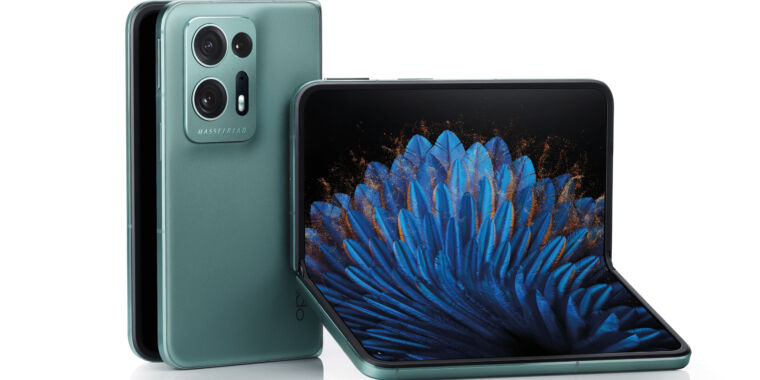-
The Oppo Find N2.
Oppo -
The cover display is short and fat.
Oppo -
Here’s a good look at the inner display.
Oppo -
The Color 13 (Android 13) homescreen looks almost like a tablet.
Oppo -
Look at how tiny this is.
Oppo -
Yep: small.
Oppo -
The spine.
Oppo -
Laptop mode.
Oppo -
An internal shot.
Oppo
Oppo has a new set of foldables with some interesting designs: Meet the Oppo Find N2 and the Oppo Find N2 Flip. Just like Samsung’s lineup, these are big and small foldable phones, but both offer something unique.
First up, the Oppo Find N2 is the company’s flagship foldable. It’s a phone that opens up into a tablet for 7,999 yuan (about $1,147). This one is a China-only release for now, but there’s always a chance Oppo’s sister company, OnePlus, makes good on all its teasing and jumps into the foldables market with a similar design.
We should talk about the dimensions of this phone first because they are very different. When folded up, the phone is 132.2×72.6×14.6 mm. That’s a normal width, but the phone is extremely short. The 132 mm height makes the Find N2 as tall as an iPhone 13 Mini. The short height explains the 120Hz, 5.54-inch front OLED display. I don’t know if it’s right to call this “small” since at 72.6 mm wide, it’s still as wide as a normal smartphone, but it’s a unique form factor.
Open the phone, and you end up with a nearly square 132.2×140.5×7.4 mm device featuring a 120 Hz, 7.1-inch flexible OLED. Oppo’s foldables use the same “flexible glass” cover as Samsung, which means there’s a very thin layer of glass in the middle of the screen, while the outside is a plastic, non-removable screen protector. Inside is a Snapdragon 8+ Gen 1, 12GB of RAM, 256GB of UFS 3.1 storage (there’s also an upgraded 16GB RAM, 512GB SKU), and a 4,520 mAh battery with 67 W charging. There are three rear cameras: a 50 MP main, 40 MP ultra-wide, and a 32 MP, 2x telephoto. There are two 32 MP hole-punch cameras for selfies and video chat—one in each screen. You also get a side-mounted fingerprint sensor.
A big part of Oppo’s sales pitch is the weight of this device, which is only 233 grams—42 g less than the similarly sized Find N1. That’s in the realm of a normal smartphone—one of the heaviest mainstream phones is the iPhone 14 Max, which weighs 240 g.
-
The (checks notes) Oppo Find N2 Flip. I feel like you could cut at least one of those words from the name.
Oppo -
Anyway, it’s a flip phone. It looks cute.
Oppo -
A shot of the inside display. These are normal smartphone onces you open them up.
Oppo -
The front display runs these custom mini apps.
Oppo -
The phone half-open.
Oppo -
The insides.
Oppo
The Oppo Find N2 Flip is Oppo’s answer to the Galaxy Flip and is a normal-sized smartphone that folds in half for 5,999 yuan ($860). Officially, the Flip is coming to “most countries in Europe” in Q1 2023, and who knows when OnePlus will decide to raid the Oppo parts bin for similar devices. This makes sense since the Flip 4 is Samsung’s bestselling foldable.
For specs, you get a 6.8-inch 120 Hz, 2520×1080 flexible OLED, a Mediatek Dimensity 9000+ SoC, and a 4,300 mAh battery with 44 W charging. The Mediatek chip is a rare one to come across our desks, but it’s a 4 nm chip with one ARM Cortex X2 CPU, three A710s, four A510s, and an ARM Mali-G710 MC10. It’s basically a Snapdragon 8 Gen 1 with a worse GPU.
The 4,300 mAh battery is impressive. A big downside to Samsung’s flip phones has been the battery life. The hinge in the middle of these phones both takes up a ton of space and cuts the battery in half, so the Galaxy Flip 4 only manages a 3,700 mAh battery. A solid slab phone in this size would have around a 5,000 mAh battery, so it’s still a trade-off, but Oppo is closer than ever to a reasonable battery size.
The front display looks like a tiny smartphone! It’s a 3.23-inch 60 Hz, 720×382 OLED. Rather than squinting at a scaled-down smartphone UI, this runs a custom interface with little mini-apps showing things like the weather, music, camera viewfinder, and notifications.
For cameras, you get a rear 50 MP main camera, a rear 8 MP ultrawide, and a 32 MP selfie cam. There’s also a side fingerprint sensor.
-
Oppo really leans into the “Fashion phone” vibe—your phone is now a tiny leather handbag.
Oppo -
Yep, it’s a purse.
Oppo -
When open, the strap gives you something to hold on to.
Oppo -
Can the loop actually be a kickstand? That would be interesting.
Oppo
I’ve called these new-age flip phones “Fashion phones” before because the form factor cranks up the price while adding basically nothing in terms of functionality. When open, they mostly feel like a normal smartphone, just with a smaller battery and a fragile screen. Oppo is really leaning into the “fashion” vibe with the N2 Flip: check out the optional leather case that turns the phone into a tiny handbag complete with a small hand strap. It’s adorable.








